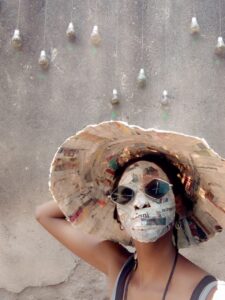
I grew up in a neighbourhood next to Kibera, so even as a child I found some joy looking for treasures in heaps of trash with my childhood friends. I would then take these objects back home and tell elaborate stories about them. So using found objects has always been a norm.
Thadde Tewa meets Moira Bushkimani from Kenya.
Moira Bushkimani posing with her work | Courtesy the artist
The journey of Moira Bushkimani
I first came across Moira Bushkimani’s work in 2017 at a pop up show she had organized at Bric a brac in Karen Nairobi, a friend’s antique store which has now evolved into an artist’s studio space and a hub for cultural events. Later on I saw her work again in 2018 as part of the Brush Tu Art Studio group exhibition with Polka Dot Art Gallery in Karen, Nairobi.
In this specific show, Moira was showing a totally different body of work titled Memory of fire which until now, never left my subconscious – this series consisted of two sculptures made out of found old wood, wire and beads. To better my understanding of her work, creative process, studio practice and art journey, I’ve met Moira twice this year; at Redhill Art Gallery, Nairobi in february and in May at her Brushtu Art studio, in Buruburu, Nairobi. Our most recent studio conversation began with her explaining the concept behind her 2018 work; Memory of fire.
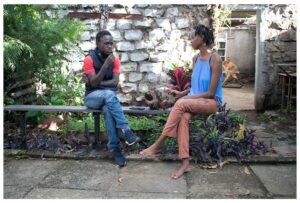
Thadde Tewa in studio conversation with Moira Bushkimani, Brush Tu Studio Collective, Nairobi | Photo: Calvin Mwanza | May 2021
Memory of fire
Moira begins her narration by confessing that she first learnt how to make a fire at the age of 23. This revelation shocked me because for me, I learnt to make a fire when I was so young. This very interesting revelation led us to an interesting conversation about how the situation has changed over the years. With the new era of television, smartphones and internet, it’s not common nowadays to find people making a fire or even sitting around a fire talking.
“I collected two pieces of wood while living at the edge of the Nairobi national park. I collected them because they had been disqualified from being used as firewood due to their thickness. This act gave me some kind of a sentimental feeling because I was going to turn them into something valuable” she begins to explain.
Moira goes ahead to explain how the idea Memory of fire came to reality. Her intention was not only to try to depict a fire with the two old pieces of wood but also to maintain the true character or nature of the two pieces of wood as she found them, to her, they seemed to have been thrown away because they were not liked, loved or wanted. Other materials she used to achieve the end product were; wire – metal – to depict the movement of fire, beads which were red in colour to depict sparks – flames. Isn’t that so unique and fascinating?
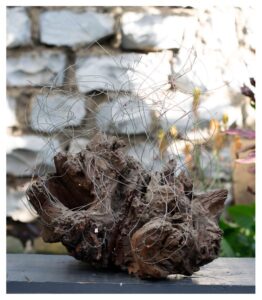
Memory of fire | Courtesy the artist
We move away from her memory of fire to understanding why fire has become an important medium or element in her creative process.
Moira has been exploring different ideas, mediums and artistic practices; she makes collages and sculptures with found materials and at the same time she’s pursuing photography as a means to express her deepest thoughts and feelings.
“Fire has become part of me, I’ve come to love it. I think it’s best when I burn my material, not everything, but part of what I want to work with. There is a performance and photography sequence titled Fire birth that I did in 2018 during a collective collaboration with Canadian artists. In this sequence it appeared that I was bathing in fire. This was basically a long exposure stop motion series shot in a dark room, inspired by Rebirth, a theme chosen by me and my project partners.” she explains.

Fire birth, 2018 | Performance & Photography | Courtesy the artist
Early career development, mentorship & studio practice
Moira was fortunate enough to attend a high school that had an active and great art department. She credits her high school art teacher as her first mentor.
“I spent most of my time either in the sports field or in the art room with her,” she narrates.
In highschool she worked with acrylic paints doing murals, fashion design drawings and model building for interior design projects. After high school it took Moira eight years to return to art as a potential career. Although in Malaysia she had her first experience with photography, a story she later revisits.
Bushkimani also credits Otieno Kota’s Ayany studio and Maasai Mbili Artist studio collective in Kibera, Nairobi as her first studio space to get mentorship and experience. At Ayany studio by Otieno Kota, she was introduced to a drawing routine and working with burnt Mabati – which is Iron sheet.
Same year, 2013, Maasai Mbili Artist studio collective put her through a programme they referred to as a “Deschooling” residency. Here she was largely an observer, experimenting on different styles with tips and advice from the resident artists.
Moira found this very exciting because it allowed her to pick up on where she had left in 2011 where she had begun to make jewellery with found wire – metals and materials. This time gave her the courage to become who she is today, above all the freedom to use unconventional materials and trust her inner voice.
“I would say I got to know myself or rather get my voice as an artist between 2013 and 2016 because I moved with the flow, tried out many methods of expressing my observations, thoughts, desires and personal philosophies. According to me this process never ends, but I think 2016 was an important year of my career because I found a style and confidence to create my first series of 17 pieces.” she concludes.
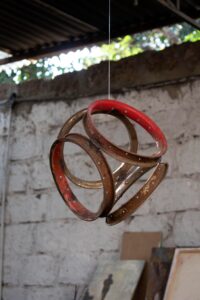
Taurus | satellite | Dimensions: 24cm x 24cm x 24cm | Medium: Steel | Courtesy the artist
Moira joined Brush Tu Art Studio Collective in 2018, an opportunity that came later after she attended a residency organized by the studio collective in 2017.
“I was really honoured to be invited back to Brush Tu Art Studio, this time to become a member. I strongly believe wherever there are artists gathered with a common interest there will always be a positive impact. Sharing resources, information, skills – from the obvious to the obscure – and artistic discussions are some of the benefits of a studio collective membership.” she explains.
To further this conversation about Brush Tu Art studio collective and Bushkimani’s studio practice, I reached out to fast rising Kenyan artist Maina Boniface – who is also the co-founder of the eight year old studio collective. Boniface describes Moira as a unique, industrious, passionate and very creative artist, who comes to the studio every single working day with new ideas, found materials and energy.
He later on opens up how he feels about co-founding Brush Tu art studio collective from scratch eight years ago, which has grown organically to a bigger and better studio collective despite the many limitations then. Above all creating an opportunity for many fellow emerging and unique artists like Bushkimani to freely create and grow without being distracted by the harsh economic realities of the East African art market.
Maina describes the feeling and experience as bitter sweet as he narrates how Brush Tu art studio collective began as an idea because they (co-founders) were frustrated by the unpredictable art market and an exclusive incapacitated art industry then.
“It wasn’t easy to access information or opportunities to learn or exhibit from the existing commercial galleries, key players or artists’ spaces then, let alone selling an artwork. So we had to come together, join our efforts, share ideas and resources in order to get through those difficult days. It’s been a journey, but definitely a beautiful one.” he discloses.
Also he shares a series by Moira titled “Ready for the Internets. His and Hers” – part of his very unique private collection – that he bought from her in 2017 while showcasing at the Sarit Centre’s Kenya Art Fair in an all women art collective booth called Ziwa Zambarau.
“As an artist I’ve been striving to support and collect other fellow artists’ work whenever I can. When I came across this series by Bushkimani, I found it to be so unique from what everyone else was showing at the fair. Now as I enjoy and study these two works closely at the comfort of my home I discover unique details and elements that I find so exciting and fascinating; in the process they arouse so many reactions and questions. For instance, the materials or found objects; the wood substrate used as a base, why this particular wood? Also why the painted background and the unique collage using burnt metal. And then lastly the concept or statement she’s trying to put across.” he explains.
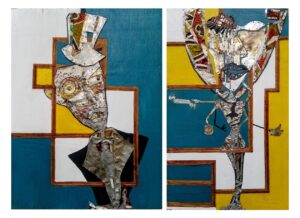
Ready for the Internets. His and Hers | Left: 76cm x 57.5cm | Right: 76cm x 46cm | Courtesy the artist
This transformative use of found objects, materials and burnt metal, is a style Moira evidently inherited from her mentors; Ayany studio by Otieno Kota & Maasai Mbili Artist Collective. She also confesses that she’s had this habit of rummaging through trash heaps in search for materials that could later be given a new form and meaning.
“I grew up in a neighbourhood next to Kibera, so even as a child I found some joy looking for treasures in heaps of trash with my childhood friends. I would then take these objects back home and tell elaborate stories about them. So using found objects has always been a norm. Sometimes my choice of found materials as a medium is influenced by economic factors. For instance, I could be struggling financially, and art materials such as canvas and paint being costly. I would go for my found materials and objects. The act of using my hand to twist and pull, hammer, the 3D nature of it, gives me a nice feeling.” she narrates.
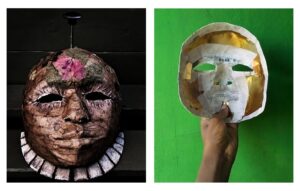
Work in progress | ‘Phases’ series 2021 | Courtesy the artist
Out of curiosity I ask her about a few woodcut prints in her body of available works, she responds by telling me that her interest in printmaking grew after a workshop. To her, the medium often varies depending on the message but not as a rule.
“There are different aspects that can only be expressed in specific mediums due to their figurative nature etc.” she adds.
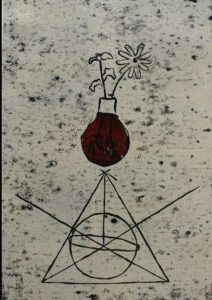
The 23rd Wobble, 2020 | Woodcut print on paper | 30cm x 42cm | Courtesy the artist
Moira began her year busy with a group exhibition organized by Brush Tu studio collective in Buruburu, Nairobi. She goes ahead to discuss some of the unique pieces she was showing among others.
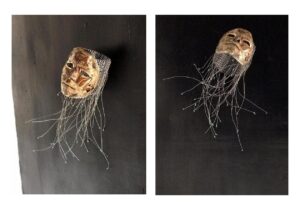
Afloat | Dimensions: 51cm x 44cm x 31cm | Medium: The mask is a paper mache cast of Moira’s face structurally reinforced with fired beer cans. The surface has flowers and feathers. There is also a motor air filter “head” attached to the mask. Wire and beads for bubbles | Courtesy the artist
Afloat is a continuation of Moira’s “I am Flora ‘‘ series which questions human nature and our identity as sentient beings with needs much like any other creature in the animal kingdom. The use of masks is for invocation of this identity. It also visits the elements of air and water.
“Afloat is a water spirit, dedicated to all things water brings forth.” she explains.
One of Moira’s intentions with this ongoing series is to talk about and inspire a nostalgia for the wild places she used to play as a child. She feels such spaces are now scarce. She also feels that it’s our duty to defend these spaces for the future generation.
She further explained to me that there is a huge difference on the current map of Nairobi in comparison to the 80’s.
“There were fields at regular intervals titled “playing fields” ; which are now all gone. In these places were meadows, swamps, different flora and fauna which we explored as kids. If you didn’t go home dusty, you were muddy and itching to the point of madness.” she adds.
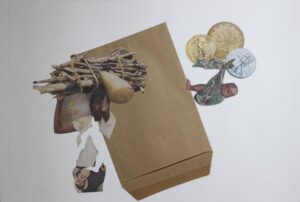
Foreign interest, 2020 | Paper collage on paper | 65cm x 49cm | Courtesy the artist
Another very unique socio-political collage piece that got my attention is Foreign interest. The brown envelope; which dominates in the artwork, and also the foreign currencies, are very intentional and symbolic. Also the African mother with firewood, a Kikapu – which is an African basket – and child were also very intentional according to Moira.
This piece addresses an economic crisis and migration, issues that most African countries are currently facing.
“For some time, African nations have been receiving loans and strong arming by foreign nations, this has become a trend which comes with a heavy price that we are paying. For instance, our very brilliant African sons and daughters are migrating to western nations in pursuit for greener pastures, away from their motherland and families leaving them in abject poverty and debts or loans that are being offered by these very countries.
As mentioned earlier each idea or statement needs its own unique medium or material, in this case paper “cut outs” and collage felt appropriate for this specific idea or statement. The Bahasha – meaning envelope – is to this day a symbol of empowerment – meaning one is doing or carrying something important. There was a time when only the “educated” carried a brown envelope and that brown paper was authoritative and powerful. That’s why it’s between the mother and the child.” she explains.
Another older piece that I find very sarcastic and political is If you can’t beat them, run! I liked the turn around from “if you can’t beat them, join them!” This piece by Moira from 2016 speaks about the politicians, scientists and their mouthpiece and; their manipulative and controlling nature.
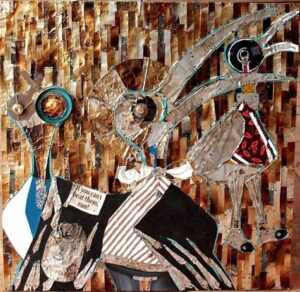
If you can’t beat them, run! The scientist, the politician, and their mouth piece | 2016 | 76cm x 76cm | Medium: Mixed media on board – Burnt metal – beer cans and fabric | Courtesy the artist
“If you can’t beat them, run – It’s a very sarcastic piece. This is the scientist, the politician, and their mouthpiece. The politician – in the middle and also the main focus – is opening his coat, and he has a beer inside his coat, next to the scientist and their mouthpiece or Media.
This specific thought and idea came to me one morning at around 6am when my favorite birds, the Ibis, came flying through the valley ” aaahaahing” supported by the echo. I’ve always found their behaviour and the sound they make very funny; and stupid. So that day I woke up laughing and got this interesting thought or rather revelation of how politicians, scientists and news presenters sounded like these birds, all singing this song in unison at the top of their lungs. So I got up and made the sketch on the board and remembered that I had a cut out from a newspaper a week before saying “if you can’t beat them, run!
On the left is the scientist in a lab coat fixing the audience with a quantum gaze, beside him is the politician, hallowed, a can of beer in the inside pocket of his open coat. And beside him is the media or mouthpiece.” she narrates.
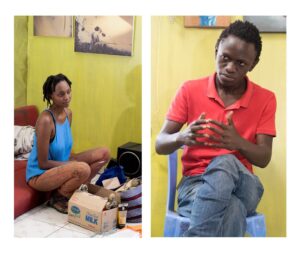
Thadde Tewa in studio conversation with Moira Bushkimani | Brush Tu Studio Collective, Nairobi | Photo: Calvin Mwanza | May 2021
We quickly wind up our studio conversation by asking her about her photography as a medium she’s been using to express herself. Moira’s journey as a photographer began in 2009 while she was in Malaysia doing her pre-university. She was invited to model for her classmate, this simple role later inspired her greatly to pursue photography.
“Her methods stunned me, as she did most of the work by herself, the props, the lighting and editing, all by herself. She made it seem so real, just like in the magazines.” Moira narrates.
In 2010, Moira teamed up with another friend and began to work on projects together, to the point it now became a commercial venture which ran perfectly in her living room. This is where her art began to reignite. But still at this point she had yet to handle a camera but she did the hair, make-up, prop making and scouted for good angles that perhaps he had not seen.
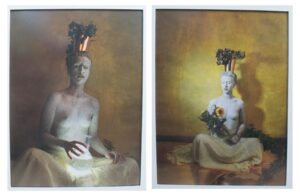
I am Flora | Photography | Courtesy the artist
A few years after returning from Malaysia, Moira narrates how she got her first opportunity to learn how to operate a manual camera while working as a photographer’s assistant in 2014. She also learnt general rules of light and framing.
“I bought my camera in 2015, interestingly I didn’t do much with it until 2016 because I was terrified of damaging or losing it if I took it far from home. So I started with doing still lifes with me as the occasional model. Later on I went into costume making and miniature photography using the objects I made or found. I deeply favour surreal settings for my photography.” she concludes.
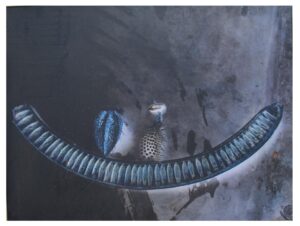
Journey II | Photography | Courtesy the artist
As I was leaving Moira’s studio I kept imagining, what I would make out of metal or beer cans? Most probably I wouldn’t start by burning the metal to make those astonishing rusty-silver sculptures. In general I’m usually amazed by her creativity and thought process. It’s very fascinating to listen to her journey, and more so how she gives found materials or objects a new beginning. Also I find her mask series, memory and love for fire mind-blowing!

Thadde Tewa in conversation with Moira Bushkimani & Dr. Hellmuth Rossler-Musch of Red Hill Art Gallery, Nairobi | Photo: Calvin Mwanza | February 2021
As most contemporary artists in Nairobi explore and focus on conventional mediums and methods of expression, Moira is everyday getting lost in her own mysterious world, she’s created for herself. Some critics would say “Moira is still finding her voice”, a common statement used to describe a brave, unconventional and creative mind. I arguably disagree, as I think Moira found her voice a long time ago. And what a beautiful voice it is.
